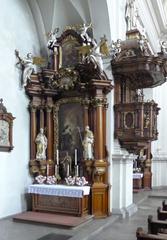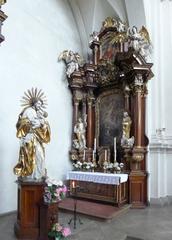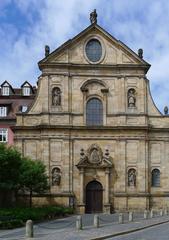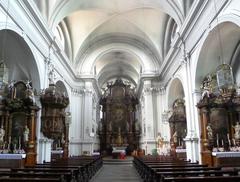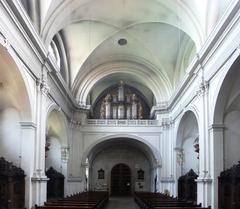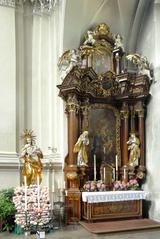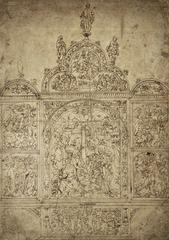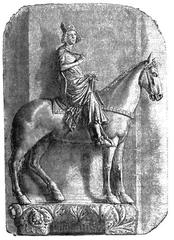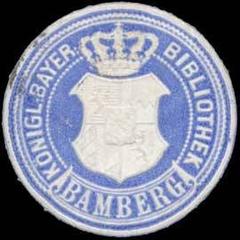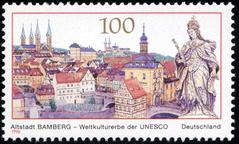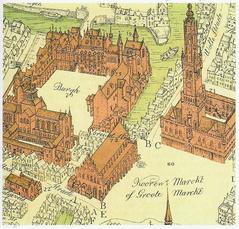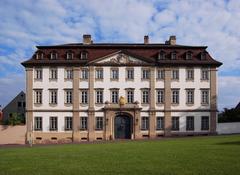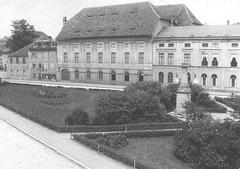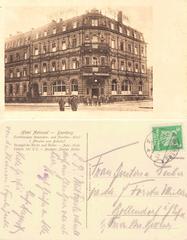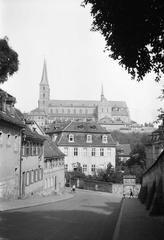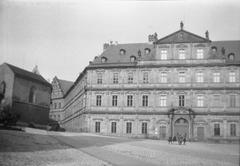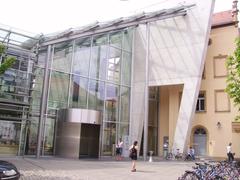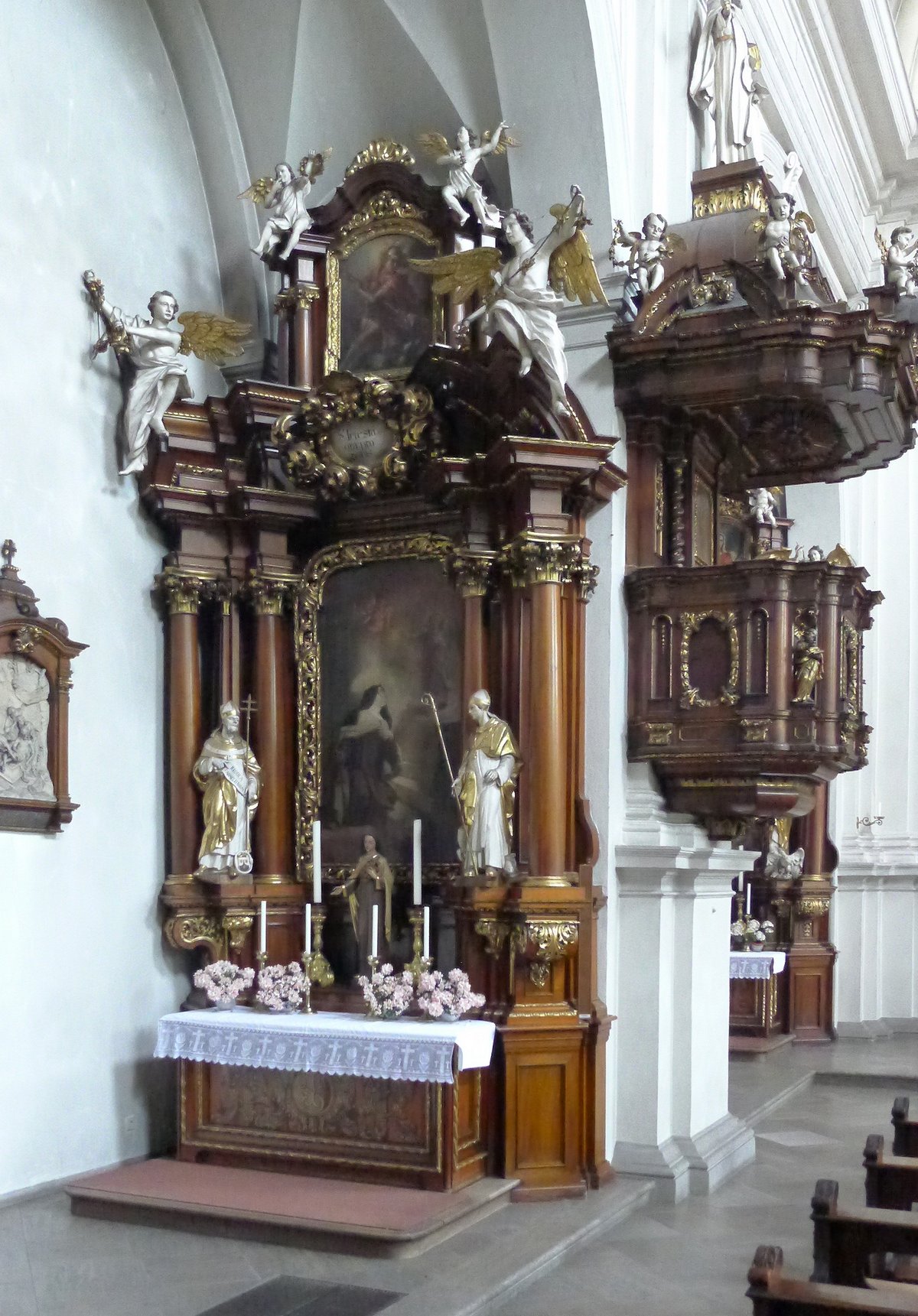
Klosterkirche St. Michael’s Church, Bamberg: Comprehensive Visitor Guide (2025)
Date: 14/06/2025
Introduction
Perched atop Michaelsberg hill, Klosterkirche St. Michael (St. Michael’s Monastery Church) is a defining symbol of Bamberg’s religious and architectural legacy. Founded in the early 11th century, the church has witnessed centuries of transformation, from its Romanesque roots to Baroque grandeur, and now stands as a pivotal part of Bamberg’s UNESCO World Heritage ensemble. Although the church interior is currently closed for restoration, the surrounding monastery grounds, gardens, panoramic terraces, and visitor center remain open, offering an immersive glimpse into Bamberg’s layered history. This guide provides detailed information on the history, architecture, visiting hours, tickets, accessibility, and nearby attractions to help you make the most of your visit.
For the latest updates, consult the Bürgerspitalstiftung Bamberg website and the Stiftung Weltkulturerbe’s Michaelsberg project page.
Table of Contents
- Historical Background
- Architectural Features and Artistic Highlights
- Visitor Information
- Nearby Attractions and Photographic Highlights
- Frequently Asked Questions (FAQ)
- Conclusion and Recommendations
- References and Further Reading
Historical Background
Foundation and Early Development
Klosterkirche St. Michael originated as the centerpiece of the Benedictine Michaelsberg Abbey, founded in 1015 by Bishop Eberhard I, soon after the establishment of the Bamberg bishopric by Emperor Henry II (Wikipedia: Michaelsberg Abbey, Bamberg). The founding monks, drawn from Amorbach and Fulda Abbeys, formed a monastic community that played a crucial role in the Christianization and cultural development of the region.
Architectural Evolution and Medieval Significance
The first church, consecrated in 1021, was rebuilt in Romanesque style after an earthquake in 1117 under Bishop Otto I, a pivotal figure in the abbey’s history (Bürgerspitalstiftung Bamberg). The 12th century marked a golden era, with reforms revitalizing monastic life and expanding the community. Following Bishop Otto’s canonization in 1189, the church became a renowned pilgrimage site, further elevating its spiritual and civic stature.
Baroque Transformations and Modern Adaptations
Successive centuries brought challenges—from natural disasters to wars—necessitating periodic restoration. The Baroque era saw the most significant transformation, with opulent facades, twin spires, and richly decorated interiors that still characterize the church’s silhouette (Wikipedia: Michaelsberg Abbey, Bamberg). In 1803, secularization dissolved the abbey, and the site was repurposed as an almshouse, later evolving into the Bürgerspitalstiftung retirement home (Mayflower Cruises & Tours).
Recent Conservation and UNESCO Status
Michaelsberg Abbey is a cornerstone of Bamberg’s UNESCO World Heritage designation (1993), recognized for its role in shaping the “Franconian Rome” (Discover Walks). In 2012, structural concerns led to the closure of the church interior, prompting a comprehensive restoration campaign focused on stabilizing foundations, repairing the roof and facades, and conserving the unique ceiling frescoes (Stiftung Weltkulturerbe). Public engagement continues through the information center and cultural events.
Architectural Features and Artistic Highlights
Romanesque and Baroque Elements
The church’s oldest sections—the forechoir, transept, and choir—date to the 12th century, showcasing robust Romanesque forms with thick walls, semicircular arches, and massive pillars (Bürgerspitalstiftung). Around 1700, Baroque architects added a striking façade, elaborate portals, and twin towers, infusing the church with dynamic movement and ornate detail typical of the period (Germany Footsteps). Later 19th-century enhancements introduced neo-Gothic vaulting, creating a harmonious blend of styles.
Botanical Ceiling Fresco—The “Himmelsgarten”
A highlight of the Baroque renovation is the “Himmelsgarten” (Heavenly Garden) fresco, covering the church’s vaulted ceiling with over 570 meticulously painted botanical species. This extraordinary artwork fuses spiritual symbolism with scientific curiosity, representing paradise while documenting plant life of the era (Bürgerspitalstiftung).
Tomb of St. Otto and Other Treasures
The Baroque tomb of St. Otto, designed with expressive sculpture and gilded ornament, attracts pilgrims and art lovers alike. The interior is further adorned with Baroque altars, dramatic altarpieces, and finely crafted sculptures, though these treasures remain inaccessible during restoration (Germany Footsteps).
Visitor Information
Current Access, Visiting Hours, and Tickets
- Interior Access: Closed since 2012 for restoration, with the reopening scheduled for spring 2026.
- Gardens and Courtyard: Open daily from approximately 8:00 AM to 6:00 PM (seasonal variations possible). The gardens provide panoramic views and interpretive displays.
- Café and Info Center: Open mid-morning to late afternoon; check the official website for up-to-date hours.
- Admission: Entry to the gardens and courtyard is free. Special events or vineyard tours may require tickets, with advance booking recommended during festivals.
Guided Tours and Special Events
While church interior tours are suspended, garden and vineyard tours are offered during seasonal events and by prior arrangement. Major events include the “Open Vineyard” wine festival and cultural programs hosted on the terraces (Bürgerspitalstiftung Bamberg). Guided walks are available through local tour operators and the Bamberg Tourist Office.
Accessibility and Amenities
- Accessibility: The hillside setting and ongoing works limit wheelchair and stroller access in certain areas. The information center and some garden paths are accessible. Contact the site in advance for current conditions.
- Facilities: Restrooms and a café are available near the courtyard. The info center offers historical displays and sells regional products (wine, honey, preserves).
Getting There: Directions and Parking
- On Foot: Reachable via a scenic 1.5 km uphill walk from Domplatz, taking 15–25 minutes through historic quarters (Happy Little Rover).
- By Car: Limited parking near the monastery; plan to arrive early on weekends or during events.
- Public Transport: Local buses serve the lower town; expect a short uphill walk to the church.
Nearby Attractions and Photographic Highlights
The monastery’s location offers commanding views of Bamberg’s old town, cathedral, and the Regnitz valley—ideal for photography at sunrise or sunset. Nearby highlights include:
- Bamberg Cathedral: A masterpiece of medieval architecture.
- Old Town Hall: Famed for its riverside setting.
- Franconian Brewery Museum: Located in the former monastery brewery cellars.
- Neue Residenz and Rose Garden: A short walk away, offering additional panoramic vistas.
Frequently Asked Questions (FAQ)
Q: Is it possible to visit the interior of Klosterkirche St. Michael?
A: No, the interior remains closed for restoration, with reopening planned for spring 2026.
Q: Are tickets required to visit the gardens and monastery grounds?
A: No, general access to the gardens and courtyard is free. Tickets may be required for special events or tours.
Q: Is the site accessible for people with disabilities?
A: The gardens and info center have some accessible paths, but the hillside terrain presents challenges. Contact the site for guidance.
Q: How do I reach the monastery from Bamberg’s old town?
A: Walk uphill from Domplatz via cobbled streets, or use public transport to the lower town and walk from there.
Q: Are guided tours available?
A: Yes, for the gardens and vineyard; check with local operators or the information center for schedules.
Q: When is the best time to visit?
A: Spring and autumn offer mild weather and colorful gardens, while summer weekends may be busier due to events.
Conclusion and Recommendations
Klosterkirche St. Michael is a cornerstone of Bamberg’s spiritual and architectural identity. Although restoration currently limits access to the church’s interior, the open gardens, terraces, and cultural programming provide a rewarding visitor experience. Take advantage of guided outdoor tours, seasonal festivals, and panoramic photo opportunities while supporting ongoing conservation. For the most current details and reopening news, consult the Bürgerspitalstiftung Bamberg and consider downloading the Audiala app for audio guides and event updates. Embrace the chance to connect with Bamberg’s living heritage at this remarkable site.
References and Further Reading
- Michaelsberg Abbey, Bamberg, Wikipedia, 2024
- Bürgerspitalstiftung Bamberg: Klosterkirche History and Visitor Information, 2024
- Mayflower Cruises & Tours: Bamberg Germany - A Tapestry of History and Heritage, 2023
- Stiftung Weltkulturerbe: Michaelsberg Restoration Project, 2024
- Germany Footsteps: Things to Do in Bamberg, 2024
- Nomads Travel Guide: Bamberg City Overview, 2023
- Happy Little Rover: Ultimate Walking Tour Map of Bamberg, 2024
- Tapped Out Travellers: Things to Know Before Visiting Germany, 2023
For more travel inspiration and audio guides, download the Audiala app and follow us on social media for Bamberg’s latest cultural highlights and restoration news.
